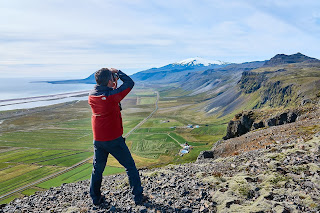More about Iceland.
And remember to click on any photo to see a larger version.
Iceland, one of the youngest landmasses on the planet, is situated on the 18,000 Km Mid Atlantic Ridge. The ridge is a rift between two of the earth's major tectonic plates, the Eurasian and North American plates, which continue to separate at a rate of 1 to 18 mm annually. Iceland was formed about 20 million years ago by underwater volcanic eruptions along the junction of the two plates. The earth’s crust in Iceland is only one third of its normal thickness and the constant rising of molten rock from within is what apparently continues to force the plates apart. The thin crust and the shifting plates are believed to be responsible for most of Iceland’s volcanic and, likely, accessible geothermal activity. Iceland’s volcanoes are in a variety of states from extinct to dormant to preparing for the next eruption. Several of the most active ones lie under glaciers or water, which apparently can lead to quite dramatic eruptions when molten lava comes in contact with ice or water. I have read that Glaciers and ice caps cover about 11% of Iceland, and we had the good fortune to see one of them today.
Today we were on the road a bit earlier as our drive north to the Snaefellsjökull Peninsula, and the Snaefellsjökull National Park was a bit longer than previous days. Our first stop was at the town of Borgarnes where we had some lunch. Here we were served by a young woman who spoke to us in perfect English. We learned from her that she and her friends learn to speak English so well through video games, music, movies and in school where they begin to study English from age 10. We also learned that they get “lots of snow” and cold (lower than -10º C) in Borgarnes and that she is planning to go to Florida! And this, it’s important to note, is the place that I left my Algarve baseball cap. :-(
If I told you these sheep were seen today that would not be true, but there were sheep almost everywhere so they fit here as well as anywhere else.
Not surprisingly, we found a number of interesting photo opportunities along the way including streams in front of spectacular mountain as well as a little church with the Snæfellsjökull ice capped volcano in the distance.


 |
| Snæfellsjökull icecap |
Snæfellsjökull is a 700,000-year-old glacier-capped stratovolcano.
According to Lonely Planet, Stratovolcanoes are sometimes called "composite volcanoes" because of their composite layered structure which is built up from sequential outpourings of eruptive materials. They are among the most common types of volcanoes, in contrast to the less common shield volcanoes. One famous stratovolcanoe with which most of us are familiar is Krakatoa.
The highlight of the day came after a drive up a deeply rutted trail which turned out to be the maintenance trail to a cell tower high above the main road, which is already well above sea level. From here we walked a couple of hundred meters further up on moss and lichen covered rocky terrain to a prime location for views of the icecap and the surrounding area.
 |
| View from atop the cell tower hill |
 |
| View from atop the cell tower hill looking east, I think. |
 |
| View from cell tower hill looking south east. |
After basking for about an hour or so on our wonderful elevated point of view, we reluctantly left this spectacular spot and moved on down the rutted trail to the highway and toward the Snæfellsjökull park - which, when we arrived, seemed anti-climatic by comparison to our earlier experience of the snow capped volcano from our “tower hill”! So we left the park shortly after arrival and continued on toward the north side of the peninsula.
Along the way we made several stops on the west side for photos of the Snæfellsjökull icecap and fields of volcanic debris in the foreground.
 |
| Snæfellsjökull volcanic icecap and volcanic debris |
When we reached the north side of the peninsula we found the beautiful small town of GrundarfjÖrður, which is reminiscent of a typical Icelandic fishing village though it may now depend more on tourism for its income than fishing. And, it almost looks as though it could be in Newfoundland! The town is surrounded by ice-capped peaks some of which were visible though not clearly as they were surrounded in fog and and mist. Somewhere nearby there is also a waterfall, which we missed.
Another point of interest nearby is the unusual, almost pyramidal shaped, iconic mountain, Kirkjufell, which some claim is the most photographed place in Iceland. Apparently one can hire a guide and climb this 493 meter high mountain. Two areas involve rope climbing which is quite dangerous especially when the surfaces are wet, which is most of the time. We decided to pass on that adventure.
 |
| Kirkjufell |
On the way back to Brekka we stopped at an interesting cluster of cone shaped hills adjacent to an area of moonscape looking terrain and streams and ponds and greenery. These cone hills are clearly not volcanic but what they are is not clear to us and, so far, I have not been able to find any information about them.
A fantastic day!
 |
| Our last evening view across the bay from Brekka Lodge |
This is our last night at Brekka as tomorrow we leave for a long day of driving to Hamragril Lodge near the town of Akureyri north and east of Brekka.
In case you're wondering, the photo, right, was not photoshopped - this is the way it looked.
In case you're wondering, the photo, right, was not photoshopped - this is the way it looked.






No comments:
Post a Comment